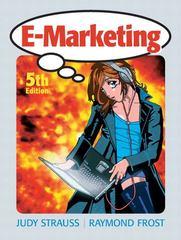Question
5 Profiling A company is interviewing candidates for a position. Candidates are from either group A or B, and the company can identify which group
5 Profiling A company is interviewing candidates for a position. Candidates are from either group A or B, and the company can identify which group a candidate belongs to. Candidates from each group 3 are similarly qualified for the position, with group A candidates being slightly better qualified than group B candidates: The probability of a candidate from group A being qualified is pA = .75 and the probability of a candidate from group B being qualified is pB = .6. In addition to the group identity, the company observes the average score of an interview test. The test score can be either L (low), M (medium), or H (high). If the candidate is qualified for the position, the probabilities that the score is L, M, and H are .1, .4, and .5, respectively, for candidates of either group. If the candidate is unqualified for the position, the probabilities that the score is L, M, and H are .6, .3, and .1, respectively, for candidates of either group.
The company's payoff is normalized to 0 if it either hires a qualified candidate or does not hire a candidate that is not qualified. The payoff is -7/3 if the company hires someone who is not qualified and -1 if the company does not hire someone who was qualified. The company's objective is to maximize its expected payoff.
(a) Let p be the posterior probability that the candidate is qualified (that is, the probability after the company observes the group identity of the candidate and the test score). For what values of p will the company hire a candidate, not hire a candidate, and be indifferent?
(b) Compute the posterior probabilities that the candidate is qualified for each possible group identity and test score.
(c) Find the optimal hiring strategy for the firm. (A strategy specifies whether or not to hire a candidate based on their group identity and their test score.)
(d) Suppose that the firm follows the optimal hiring strategy. What is the probability that a qualified candidate from group A is hired? What is the probability that a qualified candidate from group B is hired?
(e) Suppose that the firm follows the optimal hiring strategy. What is the probability that a candidate who is hired is qualified if the candidate belongs to group A? What is the probability that a candidate who is hired is qualified if the candidate belongs to group B?
(f) Suppose that the firm follows the optimal hiring strategy. Find the firm's expected payoff if it faces a candidate from group A and the expected payoff it it faces a candidate from group B.
(g) Suppose that the firm is not allowed to discriminate, meaning that it cannot use the group identity to make hiring decisions. Suppose also that candidates from group A and B are equally likely to apply to the firm. Find the firm's optimal strategy and the corresponding expected payoffs from facing a candidate from group A and from group B.
Step by Step Solution
There are 3 Steps involved in it
Step: 1

Get Instant Access to Expert-Tailored Solutions
See step-by-step solutions with expert insights and AI powered tools for academic success
Step: 2

Step: 3

Ace Your Homework with AI
Get the answers you need in no time with our AI-driven, step-by-step assistance
Get Started


